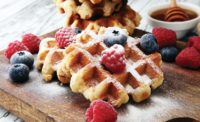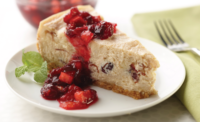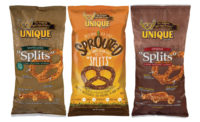The frozen breakfast food category, including waffles, pancakes and French toast, has seen relatively flat growth overall during the past year—but with pockets of positive sales data pointing toward new opportunities.
Overview | Bread | Tortillas | Sweet Goods | Snack Cakes | Pizza | Desserts | Cookies | Buns & Rolls | Bars | Breakfast Products
Top consumer trends in frozen breakfast include better-for-you product development highlighting benefits like high protein or simple ingredients, snack-size and on-the-go products that can be eaten quickly and on the run, and sometimes dessert-like indulgence, with rich flavors seen at breakfast chain restaurants finding their way into the grocery freezer case.
Market data
The subcategory of frozen waffles lost 1.50 percent in sales to $868.33 million year over the year, while frozen breakfast entrees, which contains pancakes and French toast, was up 1.62 percent to $621.7 million.
The core of frozen breakfast retail business is in frozen waffles. The segment dipped slightly for the 52 weeks ending March 19, 2017, with dollar sales down 1.50 percent to $868.3 million, per IRI, Chicago. Kellogg Co. continues to lead the segment by a wide margin, but—again—slightly down for the period, dropping 2.07 percent to $623.4 million. One high note was sales of the Thick & Fluffy line, a Belgian-style product format, up 8.84 percent to $58.6 million. Kellogg Co.’s Kashi business is reported separately and is a clear bright spot in the segment, up 37.19 percent for the year to $11.2 million.
Nature’s Path also demonstrated strong sales patterns, with its regular Organic line up 32.18 percent to $7.9 million, and the gluten-free Chia Plus waffles up 10.74 percent to $1.7 million.
IRI reports sales of frozen pancakes and French toast, and some nontraditional waffle products, within the catch-all frozen breakfast entrée segment, which was slightly up, gaining 1.62 percent to $621.7 million. De Wafelbakkers sales rose 7.87 percent to $65.1 million, while Kellogg Co.’s Eggo Minis went up 9.65 percent to $25.3 million.
Looking back
The frozen breakfast foods market has seen more experimentation in recent years, inspired by innovations in the restaurant sector, says Mike Kostyo, senior publications manager at Datassential, Chicago, who notes that the number of restaurants offering breakfast has risen every year for the past five years.
“You are seeing so many major restaurant chains looking for ways to keep their breakfast offerings unique and innovative,” he says. “In fact, more fast-casual operators offer breakfast than midscale operators, which are traditionally associated with the daypart.”
Technomic, Chicago, has noted a breakfast indulgence trend in the restaurant sector, says Lizzy Freier, managing editor, menu analysis. She mentions the limited-time offer (LTO) Cupcake Pancakes, Blackberry Cheesecake Pancakes and Sticky Bun Waffle from International House of Pancakes/IHOP; the triple-decker French Toast Melt sandwich called The King of Clubs from Perkins Restaurant & Bakery; and the Raspberry Doughnut French Toast from Another Broken Egg Café, a breakfast, brunch and lunch concept with 50 locations across 13 states.
The indulgent, dessert-like offerings found at international chains like IHOP—red velvet, cinnamon roll and cheesecake—are making their way into frozen breakfast items found at retail, Kostyo says.
“Many frozen breakfast products are also featuring seasonal flavors that have proven to be successful at major restaurant chains, like summer peach or pumpkin spice,” says Kostyo. “There are also a number of frozen breakfast sandwiches that feature pancakes, waffles or French toast as the carrier, a trend that began in restaurants.”
Kerry, Beloit, WI, has tracked several trends related to frozen breakfast products at retail, including: dessert-style offerings, exemplified by the chocolate-filled Belgian waffles from Prince Waffles; bite-size and on-the-go product offerings, such as Waffles Poppers, bite-sized chocolate chip waffle bites from Waffle Waffle, which are available only at Sam’s Club; protein-packed products, such as Van’s Power Grains waffles (10 grams of protein per serving, made with whole wheat, cracked red wheat, steel cut oats, millet and brown rice); and clean-label, simple-ingredient SKUs, like Food for Life’s Ezekiel 4:9 line of waffles.
Kerry notes several new products in the past year, based on reporting from Mintel’s Global New Products Database, that variously reflect the better-for-you and more-indulgent trends: Dark Chocolate Chip Waffles from Nature’s Path, Pancake Puffs from Good Food Made Simple, Mango Waffles from Trader Joe’s, Banana Waffles from Giant Eagle, and Oats & Berries blueberry waffles from Eggo.
Consumer data that Kerry cites from Lightspeed GMI/Mintel, from a survey of nearly 1,500 purchasers of frozen breakfast food, underscores the preference for indulgence and gourmet tastes, with 43 percent of respondents saying they would be influenced to purchase “restaurant quality options” among frozen offerings, and 40 percent by internationally inspired flavors. The desire for convenience and on-the-go frozen breakfast products prompted 32 percent to say they would be influenced by single-serve packaging.
The simple ingredient, clean-label trend shows up as well. Nearly half (49 percent) said they would be influenced by a product with fewer ingredients, 45 percent by “ingredients I recognize,” and 43 percent by organic ingredients. The survey also showed that 31 percent of millennials would eat more frozen breakfast food if they were less processed.
Looking forward
In the months and years ahead, Kostyo expects the better-for-you trend to keep growing quickly. “We’re already seeing a lot of functional nutrition in frozen breakfast items, with terms like ‘energy’ or ‘protein,’ and we’ll likely see more plant-based ingredients in the future, with options like sprouted or ancient grains,” he says.
Probiotics are also a viable option for better-for-you frozen breakfast foods like pancakes, waffles and French toast, notes Michael Bush, president and CEO, Ganeden Probiotics, Cleveland. Probiotic ingredients have already gone to a wide range of breakfast items, like cereals, bars, oatmeal and even a frozen burrito from Sweet Earth Foods. Adding probiotics to frozen breakfast items could form a nice point of differentiation.
“We’re psyched with what’s going on in this space,” says Bush. “There are lots of opportunities.”
Overview | Bread | Tortillas | Sweet Goods | Snack Cakes | Pizza | Desserts | Cookies | Buns & Rolls | Bars | Breakfast Products










